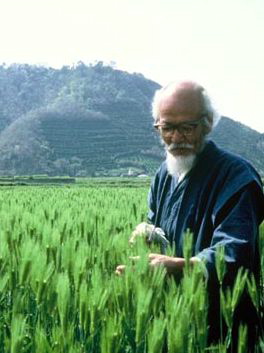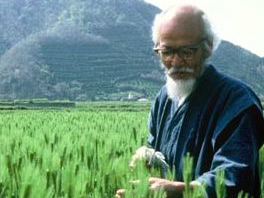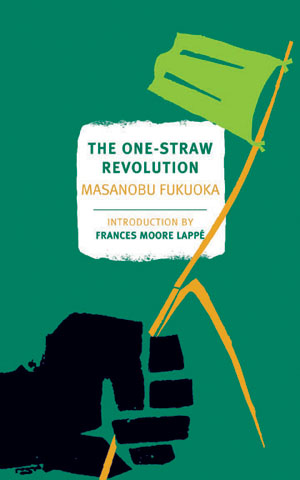
full, l
(article, Masanobu Fukuoka)
[%pageBreakSettings nobreak=true][%adInjectionSettings noInject=true] h3. From "Four Principles of Natural Farming" Make your way carefully through these fields. Dragonflies and moths fly up in a flurry. Honeybees buzz from blossom to blossom. Part the leaves and you will see insects, spiders, frogs, lizards, and many other small animals bustling about in the cool shade. Moles and earthworms burrow beneath the surface. This is a balanced rice-field ecosystem. Insect and plant communities maintain a stable relationship here. It is not uncommon for a plant disease to sweep through this area, leaving the crops in these fields unaffected. And now look over at the neighbor's field for a moment. The weeds have all been wiped out by herbicides and cultivation. The soil, animals, and insects have been exterminated by poison. The soil has been burned clean of organic matter and microorganisms by chemical fertilizers. In the summer, you see farmers at work in the fields, wearing gas masks and long rubber gloves. These rice fields, which have been farmed continuously for over 1,500 years, have now been laid waste by the exploitative farming practices of a single generation. h4.Four Principles The first is NO CULTIVATION, that is, no plowing or turning of the soil. For centuries, farmers have assumed that the plow is essential for growing crops. However, non-cultivation is fundamental to natural farming. The earth cultivates itself naturally by means of the penetration of plant roots and the activity of microorganisms, small animals, and earthworms. [%image full float=right width=268 caption="Masanobu Fukuoka"] The second is NO CHEMICAL FERTILIZER OR PREPARED COMPOST. People interfere with nature, and, try as they may, they cannot heal the resulting wounds. Their careless farming practices drain the soil of essential nutrients, and the result is yearly depletion of the land. If left to itself, the soil maintains its fertility naturally in accordance with the orderly cycle of plant and animal life. The third is NO WEEDING, BY TILLAGE OR HERBICIDES. Weeds play their part in building soil fertility and in balancing the biological community. As a fundamental principle, weeds should be controlled, not eliminated. Straw mulch, a ground cover of white clover interplanted with the crops, and temporary flooding provide effective weed control in my fields. The fourth is NO DEPENDENCE ON CHEMICALS. From the time that weak plants developed as a result of such unnatural practices as plowing and fertilizing, disease and insect imbalance became a great problem in agriculture. Nature, left alone, is in perfect balance. Harmful insects and plant diseases are always present, but do not occur in nature to an extent which requires the use of poisonous chemicals. The sensible approach to disease and insect control is to grow sturdy crops in a healthy environment. \ For fertilizer, Mr. Fukuoka grows a leguminous ground cover of white clover, returns the threshed straw to the fields, and adds a little poultry manure. \ Mr. Fukuoka grows his grain crops without chemicals of any kind. On some orchard trees he occasionally uses a machine-oil emulsion for the control of insect scales. He uses no persistent or broad-spectrum poisons, and has no pesticide "program." h4. Cultivation When the soil is cultivated, the natural environment is altered beyond recognition. The repercussions of such acts have caused the farmer nightmares for countless generations. For example, when a natural area is brought under the plow, very strong weeds such as crabgrass and docks sometimes come to dominate the vegetation. When these weeds take hold, the farmer is faced with a nearly impossible task of weeding each year. Very often, the land is abandoned. In coping with problems such as these, the only sensible approach is to discontinue the unnatural practices which have brought about the situation in the first place. The farmer also has a responsibility to repair the damage he has caused. Cultivation of the soil should be discontinued. If gentle measures, such as spreading straw and sowing clover, are practiced, instead of using manmade chemicals and machinery to wage a war of annihilation, then the environment will move back toward its natural balance, and even troublesome weeds can be brought under control. h4. Fertilizer I have been known, in chatting with soil-fertility experts, to ask, "If a field is left to itself, will the soil’s fertility increase or will it become depleted?" They usually pause and say something like, "Well, let’s see . . . It’ll become depleted. No, not when you remember that when rice is grown for a long time in the same field without fertilizer, the harvest settles at about 9 bushels (525 pounds) per quarter acre. The earth would become neither enriched nor depleted." These specialists are referring to a cultivated, flooded field. If nature is left to itself, fertility increases. Organic remains of plants and animals accumulate and are decomposed on the surface by bacteria and fungi. With the movement of rainwater, the nutrients are taken deep into the soil to become food for microorganisms, earthworms, and other small animals. Plant roots reach to the lower soil strata and draw the nutrients back up to the surface. If you want to get an idea of the natural fertility of the earth, take a walk to the wild mountainside sometime and look at the giant trees that grow without fertilizer and without cultivation. The fertility of nature, as it is, is beyond reach of the imagination. [[block(sidebar). h1. About the book and author Masanobu Fukuoka was a revolutionary farmer in his native Japan, insisting that his unconventional "do-nothing" technique was best for agriculture. The One-Straw Revolution is his manifesto, explaining not just his principles of healthy cultivation but his beliefs about the spiritual qualities of farming. Reprinted by permission of New York Review Books (2009). ]] Cut down the natural forest cover, plant Japanese red pine or cedar trees for a few generations, and the soil will become depleted and open to erosion. On the other hand, take a barren mountain with poor, red clay soil, and plant pine or cedar with a ground cover of clover and alfalfa. As the green manure enriches and softens the soil, weeds and bushes grow up below the trees, and a rich cycle of regeneration is begun. There are instances in which the top four inches of soil have become enriched in less than 10 years. For growing agricultural crops also, the use of prepared fertilizer can be discontinued. For the most part, a permanent green manure cover and the return of all the straw and chaff to the soil will be sufficient. To provide animal manure to help decompose the straw, I used to let ducks loose in the fields. If they are introduced as ducklings while the seedlings are still young, the ducks will grow up together with the rice. Ten ducks will supply all the manure necessary for a quarter-acre and will also help to control the weeds. I did this for many years until the construction of a national highway made it impossible for the ducks to get across the road and back to the coop. Now I use a little chicken manure to help decompose the straw. In other areas, ducks or other small grazing animals are still a practical possibility. Adding too much fertilizer can lead to problems. One year, right after the rice transplanting, I contracted to rent 1 1/4 acres of freshly planted rice fields for a period of one year. I ran all the water out of the fields and proceeded without chemical fertilizer, applying only a small amount of chicken manure. Four of the fields developed normally. But in the fifth, no matter what I did, the rice plants came up too thickly and were attacked by blast disease. When I asked the owner about this, he said he had used the field over the winter as a dump for chicken manure. Using straw, green manure, and a little poultry manure, one can get high yields without adding compost or commercial fertilizer at all. For several decades now, I have been sitting back, observing nature’s method of cultivation and fertilization. And while watching, I have been reaping bumper crops of vegetables, citrus, rice, and winter grain as a gift, so to speak, from the natural fertility of the earth. \Ground-cover crops such as clover, vetch, and alfalfa, which condition and nourish the soil. h4. Coping with Weeds Here are some key points to remember in dealing with weeds: As soon as cultivation is discontinued, the number of weeds decreases sharply. Also, the varieties of weeds in a given field will change. If seeds are sown while the preceding crop is still ripening in the field, those seeds will germinate ahead of the weeds. Winter weeds sprout only after the rice has been harvested, but by that time the winter grain already has a head start. Summer weeds sprout right after the harvest of barley and rye, but the rice is already growing strongly. Timing the seeding in such a way that there is no interval between succeeding crops gives the grain a great advantage over the weeds. Directly after the harvest, if the whole field is covered with straw, the germination of weeds is stopped short. White clover sowed with the grain as a ground cover also helps to keep weeds under control. The usual way to deal with weeds is to cultivate the soil. But when you cultivate, seeds lying deep in the soil, which would never have germinated otherwise, are stirred up and given a chance to sprout. Furthermore, the quick-sprouting, fast-growing varieties are given the advantage under these conditions. So you might say that the farmer who tries to control weeds by cultivating the soil is, quite literally, sowing the seeds of his own misfortune. h4. "Pest" Control Let us say that there are still some people who think that if chemicals are not used, their fruit trees and field crops will wither before their very eyes. The fact of the matter is that by using these chemicals, people have unwittingly brought about the conditions in which this unfounded fear may become reality. Recently, Japanese red pines have been suffering severe damage from an outbreak of pine bark weevils. Foresters are now using helicopters in an attempt to stop the damage by aerial spraying. I do not deny that this is effective in the short run, but I know there must be another way. Weevil blights, according to the latest research, are not a direct infestation, but follow upon the action of mediating nematodes. The nematodes breed within the trunk, block the transport of water and nutrients, and eventually cause the pine to wither and die. The ultimate cause, of course, is not yet clearly understood. Nematodes feed on a fungus within the tree's trunk. Why did this fungus begin to spread so prolifically within the tree? Did the fungus begin to multiply after the nematode had already appeared? Or did the nematode appear because the fungus was already present? It boils down to a question of which came first, the fungus or the nematode? Furthermore, there is another microbe about which very little is known, which always accompanies the fungus, and is a virus toxic to the fungus. Effect following effect in every direction, the only thing that can be said with certainty is that the pine trees are withering in unusual numbers. People cannot know what the true cause of the pine blight is, nor can they know the ultimate consequences of their "remedy." If the situation is meddled with unknowingly, that only sows the seeds for the next great catastrophe. No, I cannot rejoice in the knowledge that immediate damage from the weevil has been reduced by chemical spraying. Using agricultural chemicals is the most inept way to deal with problems such as these, and will only lead to greater problems in the future. These four principles of natural farming (no cultivation, no chemical fertilizer or prepared compost, no weeding by tillage or herbicides, and no dependence on chemicals) comply with the natural order and lead to the replenishment of nature's richness. All my fumblings have run along this line of thought. It is the heart of my method of growing vegetables, grain, and citrus.

full, l

promo-image, l

reference-image, l

feature-image, l

featurette-image, l

newsletter-image, l